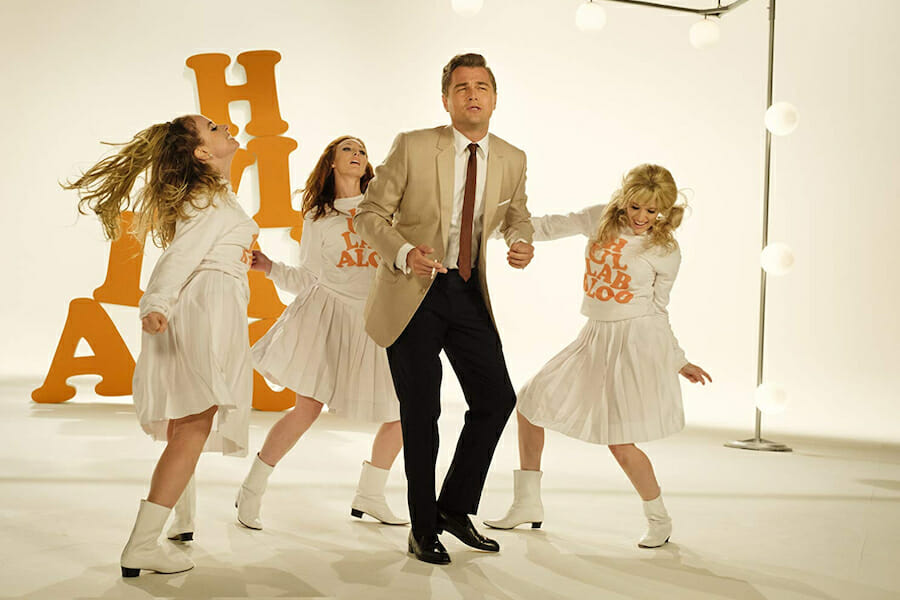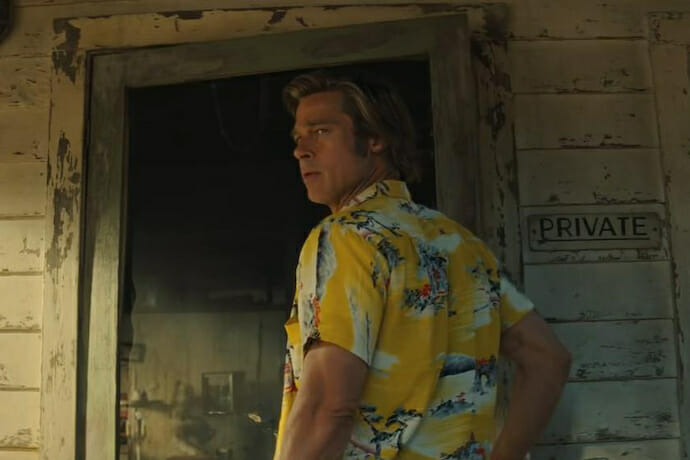
‘Once Upon a Time In Hollywood’ Review
Hippies, westerns, pompadours, catchy pop songs…all have (mostly) disappeared from our world. Back to save the day and the memories, and twist a little history, is Quentin Tarantino, the ultimate film geek. His latest, Once Upon a Time In Hollywood, reminds us of a bygone era of movie stars and old school filmmaking…a once-beloved industry which has been described as being on life support. There have been plenty of big-screen love letters to Hollywood, but few if any were filmed with so many personal touches and call-backs to the director’s own films.
In keeping with a request from Mr. Tarantino, this review will not include any spoilers or details that might negatively impact anyone’s initial viewing of the film. It’s a reasonable request since the film is so unique and literally packed with nostalgia, sight gags, and historical bits and pieces – some accurate, some not so much. There is a lot to take in and process, and the full impact of the initial viewing might result in awe, shock or disgust…and maybe even all of the above. So this will be a pretty simple overview peppered with some insight that should enhance rather than spoil the experience.
The film covers about 6 months in 1969, but in reality, it all takes place (at least what we see on screen) in 3 days. Leonardo DiCaprio (possibly his best ever performance) plays Rick Dalton, an actor who had a hit (fictional) TV western series in the ’50s and ’60s entitled “Bounty Law.” Since the show ended, Rick has been unable to make the successful transition to movies. For comparison, think of Clint Eastwood, Steve McQueen, and Burt Reynolds – all actors in TV westerns who found greater career success in movies. Brad Pitt (the epitome of cool) stars as Cliff Booth, Rick’s stunt double, friend, driver, handyman, etc. While Rick is desperate to find the next stage of his career and fend off being forgotten, Cliff, a Vietnam vet, is accepting of his lot in life. Rick lives in a swanky Hollywood Hills home next door to hotshot director Roman Polanski and his starlet wife Sharon Tate, and Cliff lives in a trailer behind the Van Nuys Drive-In with his well-trained Rottweiler Brandy.
There are multiple parallel stories to follow, and a key one involves the aforementioned Sharon Tate. Margot Robbie nails the role and bounces about town with the energy and sweet aura that we imagine she possessed. All 3 of the lead actors – DiCaprio, Pitt, Robbie – have knockout scenes that I’d love to be able to discuss, but I’m not sure how without giving away too much. What I can say is that each of these three talented actors prove that movie stars still exist.
This is Tarantino’s 9th film as a director (he counts the 2-part Kill Bill as one film), and he claims he will stop making films after number 10. There are multiple features we can count on in a QT film, and a ridiculously deep supporting cast is one. Going through each of the characters played by actors you will recognize would take a page and a half, so I’ll cover only a few here. Margaret Qualley is a scene-stealer as Pussycat, one of the Manson family girls. You likely remember her from the recent “Fosse/Verdon” or “The Leftovers” and here she fully embraces the hippie look and spirit. Emile Hirsch plays hairdresser Jay Sebring, one of those in the house with Ms. Tate on that fateful night, and Mike Moh plays Bruce Lee so convincingly that I was momentarily confused when he took off his sunglasses.

Also making appearances are some Tarantino regulars: Kurt Russell (as a stunt coordinator and narrator), Michael Madsen (as an actor), and Bruce Dern as George Spahn (a late replacement after Burt Reynolds passed away). Others of note include Maya Hawke (Uma Thurman’s daughter), Austin Butler (recently cast in the title role of Baz Luhrmann’s Elvis biopic) as Tex Watson, Rumer Willis (Bruce’s daughter) as actress Joanna Pettet, Damian Lewis as Steve McQueen, Al Pacino as agent Marvin Schwartz, Dakota Fanning as Squeaky Fromme, and the late Luke Perry as actor Wayne Maunder (“Lancer”). 90-year-old Clu Gulager (“The Virginian,” The Last Picture Show) makes an appearance and Nicholas Hammond (Friedrich from The Sound of Music) tears into his role with gusto as director Sam Wanamaker. There is even a TV Guide cover featuring the late great character actor Andrew Duggan (“Lancer”). Some of these, and many more are like cameos, but it’s still fascinating to see the faces.
1969 was 50 years ago, and Tarantino does a remarkable job of recreating the look of Sunset Boulevard, Hollywood Boulevard, Cielo Drive, and studio backlots. Much credit goes to Production Designer Barbara Ling and Set Decorator Nancy Haigh (frequent Coen Brothers collaborator and an Oscar winner for Bugsy). Arianne Phillips does a tremendous job with the costumes that look natural for the time period, and not like something right off the wardrobe racks. Three-time Oscar-winning Cinematographer Robert Richardson (Hugo, The Aviator, JFK) is back for his 6th Tarantino film, and he captures the look and feel and vibe of a time that is so personal to the director.
It’s been three and a half years since The Hateful Eight, Tarantino’s most recent film, and probably his worst received. This one is clearly personal as it captures the time and place that he fell in love with movies. The dichotomy of the rising starlet and fading cowboy as neighbors is a brilliant way to make a point about times changing. This was a time of transition in the United States – a new culture was upon us, and whatever innocence remained, was surely snuffed out on a hot August night in 1969. As usual, his use of music serves a purpose. We are treated to Roy Head, The Royal Guardsmen, and Paul Revere and the Raiders, among others. QT also shows us plenty of bare feet (another trademark). What is unusual is that the film lacks the trademark mass dialogue. This one kind of meanders…right up until it doesn’t.
Quentin Tarantino is a living, breathing film geek (that’s a compliment) who has earned the right to make the movies he wants to make. This one took him a lifetime to live, 5 years to write, and it will take you 161 minutes to watch. It was warmly received at Cannes, but no one can expect to “catch” everything Mr. Tarantino has served up in one viewing. That said, one viewing will likely be one too many for quite a few folks (especially many under 40 who have no recollection of this Hollywood). Some will categorize this as an overindulgent nostalgia trip for movie nerds. And they are likely correct. But for those of us who complain that too many movies are remakes, re-treads, and comic books, there is no denying Tarantino delivers a unique and creative viewing experience – and it’s not meant for everyone.

